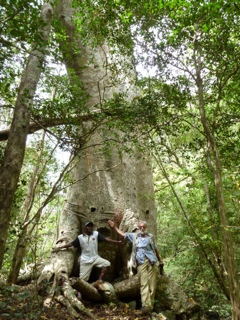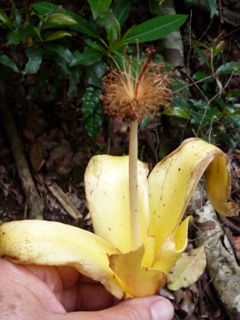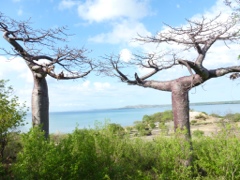The baobabs of northern Madagascar
The rarest baobab tree in the world is Adansonia perrieri. Satellite mapping by CIRAD indicates that there are fewer than 200 of these trees known to exist. We hiked for 2 1/2 hours on slippery leech infested trails in Amber Mountain National Park to see two trees beside the Antomboka River in the humid tropical montane forest. The very last place one would expect to find a tree whose relatives grow in the dry savanna of Africa. We were fortunate to find one of these trees in bloom. Large yellow flowers that look just like a banana peel (not the tasteless large bananas in North American markets, but the small sweet ones that people eat in the tropics). The staminal tube is very long and the anthers quite short. Clearly a member of the longitubae group. We found only two fruit – floating in the river. Is this because very few fruit ever set or because they are picked up (illegally) by local farmers taking a shortcut through the park. In spite of growing in a natural, undisturbed forest environment we could find no evidence of regeneration in this species. Was it a dead-end evolutionary side track? So few individuals spread over a wide area doesn’t give much hope for a sex life!
We were able to see one other perrieri just north of Ambondrofehy between Anatalaka and Anivoranu on Route 6 not far from Akarana National Park. This one is in a highly degraded tropical forest environment on a river bank. Again, no sign of fruit or of regeneration. A large injury on the lower trunk which has rotted about halfway through. Not much longer a living tree, I suspect.
Often recorded as the most widespread baobab of Madagascar is the appropriately named Adansonia madagascarensis. Without seeing the flower, it is difficult to distinguish from A. za, which is in fact the only species found from north to south on the west coast. We saw healthy reproducing populations of A. madagascarensis in natural tropical deciduous forest in Ankarana Park and in degraded forest on French Mountain. The substrate was always coarse broken limestone. Since the deciduous forest was freshly in leafy profusion, it was difficult to photograph the tall baobabs which towered over the diversity of surrounding trees. None was blooming when we were there.
The other species confined to the north of the country is A. suarezensis, named presumably after the colonial naval port city of Diego Suarez, now known as Antsirarana. This species has very restricted distribution in the north of the country. We were unable to visit the sites west of Antsirarana where it is supposed to be most numerous due to the rains making the roads impassible in January. “Well, we might be able to get there, but then not be able to get back.” We found a few individuals of suarezensis at French Mountain in the degraded forest next to madagascarensis and on the same coarse substrate. There was no sign of regeneration of this species there except where it had been planted in front of the now closed King Lodge resort. Since the large botanical garden planted by the owners was also closed, we were unable to see how successful the attempts were to re-establish a healthy population there. Suarezensis is a really beautiful tree with a smooth golden red bark and regal stature. It’s a shame we didn’t get to see it in a happier environment.
A. perrieri on Antomboka River
Flower of A. perrieri
madagascarensis in Akarana forest
suarezensis at French Mountain




Leave a Reply